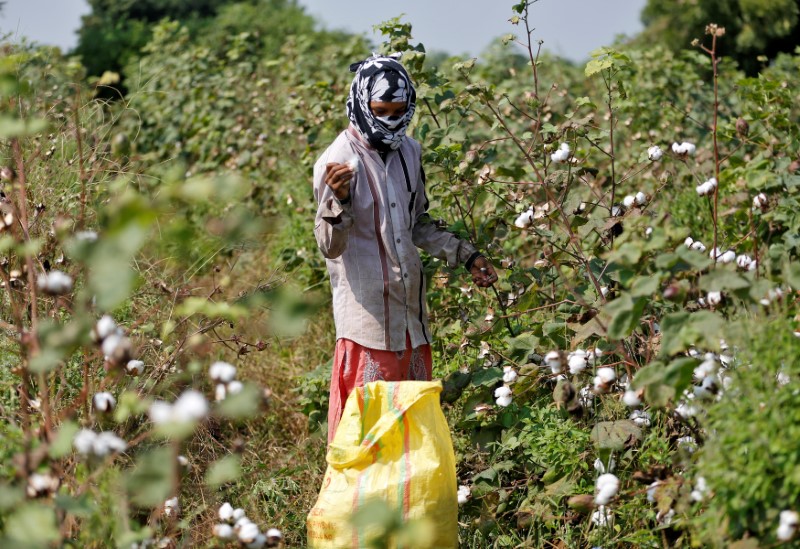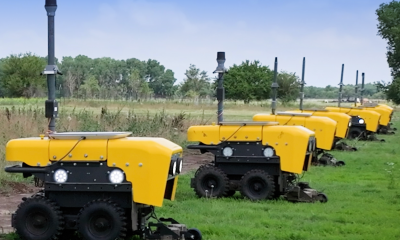Investing
Exclusive-US Customs finds garments made with banned Chinese cotton -documents

© Reuters. FILE PHOTO: A worker moves freshly harvested cotton at a processing plant in Aksu, Xinjiang Uighur Autonomous Region, December 1, 2015. REUTERS/Dominique Patton/File Photo
By Katherine Masters
NEW YORK (Reuters) – Roughly 27% of tests performed on shoes and garments collected by U.S. Customs and Border Protection in May showed links to cotton from China’s Xinjiang region, which has been banned because of concerns over forced labor, according to documents obtained by Reuters under the Freedom of Information Act.
The results, which have not been previously reported, highlight the challenges of complying with the U.S. law aimed at blocking imports of cotton linked to forced labor in China. It requires cutting out the far western region from apparel supply chains.
To help enforce the law, customs officials have turned to isotopic testing, which can link cotton to specific geographic areas by analyzing the concentration of stable elements like carbon and hydrogen present in both the crop and the environment in which it has been grown, experts say.
Ten of the 37 garments collected by Customs and Border Protection in May returned as “consistent” with Xinjiang, the documents show. So far, officials have collected at least three batches of footwear and apparel as part of their enforcement efforts, on Dec. 22, 2022, April 11, 2023, and on May 23, 2023, according to government documents released to Reuters.
Overall, 13 of 86 total tests, or 15%, were deemed to be consistent with Xinjiang.
Much of the other information on the documents was redacted, including brands of the garments that were tested. Descriptions of the items detail a range of apparel, from boxers, jeans and tee-shirts to baby onesies and dresses. All contained cotton, in some cases mixed with other textiles such as spandex and rayon.
One item collected in May that returned as consistent with Xinjiang was described as a “Mickey T-shirt” made from a blend of cotton and polyester. Laura Murphy, a professor of human rights and contemporary slavery at Sheffield Hallam University in England, said the range of products and high rate of positive samples underscored the difficulty of enforcing the ban.
“The amount of Xinjiang cotton entering the U.S. should be zero,” she said. “So, anything above zero percent should be a real warning.”
Customs officials did not immediately respond to questions about the test results, including how they selected garments for the analysis.
In June, the agency told Reuters in June it “prioritizes action against the highest-risk goods based on current data and intelligence,” but said sharing more details publicly would “compromise the success of our work and therefore U.S. economic and national security.”
Isotopic testing is not yet a “routine process” for U.S. Customs, Eric Choy, the agency’s executive director for trade remedy and law enforcement, told Reuters in June. He added that officials at individual U.S. ports can request testing if they receive allegations about specific shipments or suspect the goods have links to Xinjiang.
Many retailers have also turned to isotopic testing in a bid to keep their supply chain free of cotton with links to forced labor. Goods produced partially or entirely in Xinjiang are banned in the U.S.
A federal report published last year estimated that cotton from Xinjiang accounted for roughly 87% of China’s production and 23% of the global supply in 2020 and 2021. Countries including Vietnam, Cambodia and Bangladesh — some of the world’s largest producers of cotton clothing and consumer goods — still import large quantities of finished fabric from China. It then often makes its way to the U.S. in the form of apparel made by suppliers in those countries, according to the report.
Retail executives and testing companies told Reuters that isotopic analysis is often used to verify that suppliers are only using cotton sourced from approved locations, such as the U.S. or India. Victoria’s Secret, Ralph Lauren (NYSE:), and ecommerce giant Shein are among the companies that contract with Oritain, an isotopic testing company headquartered in New Zealand, to verify the origin of cotton in their supply chains.
U.S. Customs and Border Protection does not perform its own testing and has paid Oritain more than $1.3 million since 2020 for cotton goods analysis, according to records from the agency obtained by Reuters under the Freedom of Information Act. However, the agency redacted the name of the provider that analyzed the three batches of footwear and apparel collected in December, April and May, and did not immediately confirm whether Oritain had performed the testing.
Officials said isotopic testing alone is not enough to clear shipments detained at U.S. ports for suspected links to Xinjiang. More retailers and manufacturers are “spot checking” materials from yarns to finished fabrics at various points in their supply chains using the analysis. Still, there is no guarantee those same materials were used in the finished products being investigated, according to Choy.
“It’s not a silver bullet,” he said. “Testing that’s done at the spinning level or the yarn level of the supply chain doesn’t necessarily represent the actual shipment.”
Read the full article here

-

 Side Hustles4 days ago
Side Hustles4 days agoWhy the Best CEOs Think Like Anthropologists
-

 Make Money5 days ago
Make Money5 days agoEarn More in 2025: Top 10 High-Yield Savings Accounts Revealed
-

 Side Hustles7 days ago
Side Hustles7 days agoLA Rental Prices Skyrocketing Despite Price Gouging Laws
-

 Side Hustles7 days ago
Side Hustles7 days agoHow to Craft Marketing Campaigns That Reach Multiple Generations
-

 Side Hustles5 days ago
Side Hustles5 days agoWhat to Do If TikTok is Banned — How to Protect Your Brand
-

 Side Hustles5 days ago
Side Hustles5 days ago10 Roles That Are Surprisingly Well-Suited for Outsourcing
-

 Side Hustles6 days ago
Side Hustles6 days agoMeta Is Laying Off 5% of Its Workforce: Read the Memo
-

 Passive Income5 days ago
Passive Income5 days agoHow Pets Can Promote Better Health and Well-Being in the Workplace


















